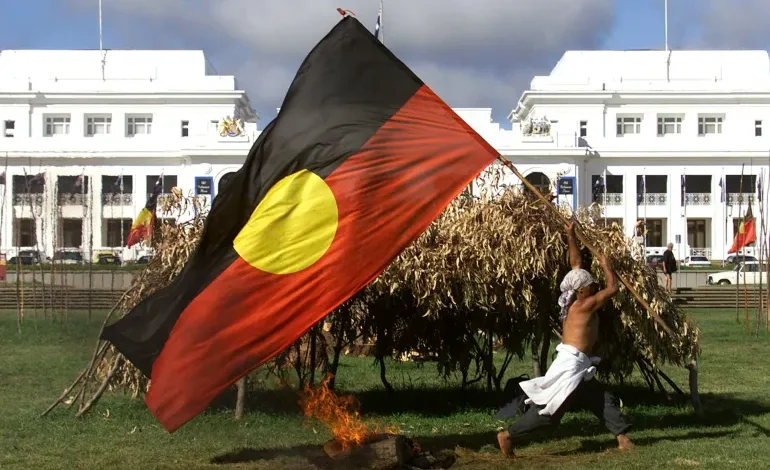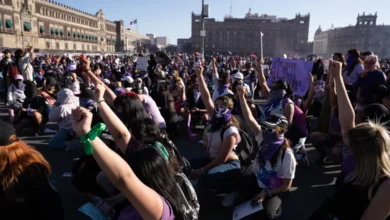Timeline: Indigenous Voice, treaty and truth in Australia

The Australian referendum on an Indigenous Voice to Parliament is part of a long history of Aboriginal people fighting for their voice to be heard.
The referendum was called after Aboriginal and Torres Strait Islander leaders issued the Uluru Statement from the Heart, a petition calling for a First Nations Voice to be enshrined in the Australian constitution.
The Uluru statement is the latest of many petitions and protests from Aboriginal people calling for three separate processes known as Voice, Treaty and Truth, in varying orders.
Australia has made limited progress on implementing any of the processes, and unlike neighbouring New Zealand and other similar countries, does not have any treaties with Indigenous people.
But, the authors of the Uluru statement say 60,000 years of ancestral ties between Indigenous people and the land are a “sacred link” that should not disappear from world history in “merely” 200 years.
As Australia heads to the polls on Saturday, October 14, here’s a look at some of the significant moments in that long history:
50,000 years ago: Murujuga rock art
The estimated one million petroglyphs at Murujuga in Western Australia are among many examples of Indigenous rock art recording Indigenous history around the country.
Since before the last Ice Age, Murujuga artists have been painting animals, many of which are now extinct, such as nail-tailed wallabies and thylacines, also known as Tasmanian tigers. But traditional owners fear the paintings could be the latest Indigenous heritage site to be damaged or destroyed, due to a gas project in the area.
30,000 years ago: the Story of Budj Bim
The Gunditjmara people’s story of their ancestral creation-being who revealed himself during a volcanic eruption that last happened 30,000 years ago has made some people say the story of Budj Bim could be the oldest living story on Earth.
A 6,600-year-old aquaculture system of weirs, channels and fish traps at Budj Bim received World Heritage listing from UNESCO in 2019.January 26, 1788: ‘Invasion Day’
January 26 is the date that Captain James Cook and Britain’s First Fleet arrived in Botany Bay in present-day Sydney in 1788.
The date is now a public holiday known as Australia Day but is marked each year by thousands who take to the streets in Invasion Day protests.
1937: Petition for citizenship, land rights and representation
In 1937, William Cooper, the Secretary of the Australian Aboriginal Advancement League, delivered a petition signed by more than 1,800 people to the then-King of England, George VI. The petition called for representation in parliament, citizenship and land rights for Aboriginal people. Australia’s six British colonies became a federation on 1 January 1901, but the British monarch, now King Charles III, remains Australia’s head of state through their representative, the governor-general.
January 26, 1938: Day of Mourning
On January 26 1938, the Australian Aborigines League (AAL) and the Aborigines Progressive Association (APA) organised a day of mourning at Australia Hall in Sydney.
They held banners and released a statement saying: “[We] hereby make protest against the callous treatment of our people by the white men during the past 150 years.”
The statement also called for “full citizen status and equality within the community” for Aboriginal people. Aboriginal people have been able to vote in Australian federal elections since 1962, but they still face inequality in many areas, including health, and are more likely to be jailed than other Australians.
1963: Yirrkala bark petitions
The Yolngu people from Yirrkala in eastern Arnhem Land in the Northern Territory sent bark petitions to the Australian parliament in Canberra in 1963. The paper petitions were framed with bark paintings mapping the land of the Yolngu peoples, which were being prospected for mining without their consultation.
1965: Freedom Rides
In 1965, Charlie Perkins, one of only two Aboriginal students at the University of Sydney at the time, led a group of Aboriginal and non-Aboriginal students on a bus ride through regional towns where they protested about segregation, including at the Moree swimming pool.
1972: Aboriginal Tent Embassy established
In 1972, the Aboriginal Tent Embassy was established on the lawns in front of Parliament House in Australia’s national capital Canberra. The tent embassy has continued ever since, although it has evolved to include shipping containers and other structures.1980s: Protests grow
During the 1980s, Aboriginal people and their supporters held a series of peaceful protests, including in 1982 when Australia hosted the Commonwealth Games, a sporting event for current and former colonies of the British empire.
Protests also took place around the country in 1988, as the government and many Australians held celebrations to mark 200 years since Captain Cook’s arrival in Botany Bay.
1990-2005: The Aboriginal and Torres Strait Islander Commission (ATSIC)
Established by a Labor government in 1995, the Aboriginal and Torres Strait Islander Commission (ATSIC) was an Australian government body in which Aboriginal Australians and Torres Strait Islanders could formally be included in government processes affecting their lives. ATSIC was later abolished in 2005, by the then-conservative government led by Prime Minister John Howard. The proposal to enshrine the Voice to Parliament in the Australian constitution would mean that it would be more difficult for future governments to abolish the body without needing to hold another referendum.
1991: Yothu Yindi’s song Treaty
Sung in both English and Gumatj language, the protest song Treaty was released by the band Yothu Yindi in June 1991 and quickly climbed towards the top of Australian and international music charts.
The song came after the then-Labor government failed to live up to promises it had made to consider introducing a Treaty process.
1992: Eddie Mabo overturns ‘terra nullius’
In 1992, the High Court of Australia overturned the claim made by Britain at the time of colonisation that Australia was “terra nullius”, land belonging to no one, in the historic Mabo vs Queensland case.
Eddie Mabo, who brought the case as he fought for recognition of his ancestral lands in the Torres Strait Islands, passed away a few months before the decision was announced.
Native Title laws in Australia now give some limited recognition of Indigenous people’s connection to their land, but are not comparable with treaty agreements.
2008: Australia says ‘Sorry’
On February 13, 2008, Prime Minister Kevin Rudd stood up in parliament to make a formal apology to Aboriginal and Torres Strait Islander peoples, and, in particular, the Stolen Generations – tens of thousands of people who had been forcibly removed from their families as children under an official assimilation programme that continued from the mid-1800s into the 1970s.
For the first time, the Federal Parliament opened for the year with a Welcome to Country ceremony conducted by local Aboriginal people.
2017: The Uluru Statement from the Heart
In 2017, Aboriginal and Torres Strait Islander leaders selected as delegates to the First Nations National Constitutional Convention gathered at Uluru in central Australia where they wrote and released a petition known as the Uluru Statement from the Heart. The Uluru statement was later considered to be the driving force behind the 2023 Australian referendum on a Voice to Parliament, although the statement also called for a truth-telling body to later be established as well.










